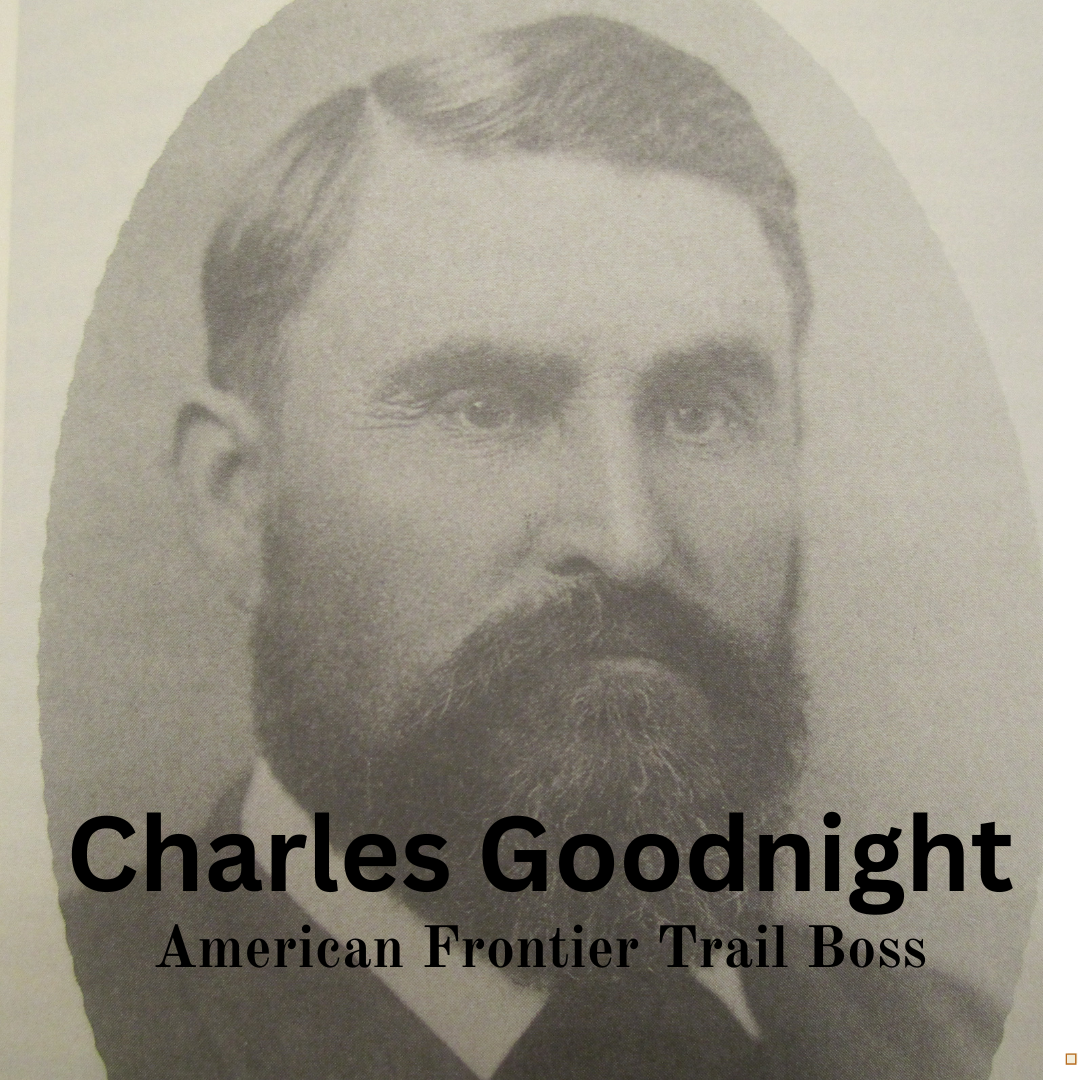
Charles Goodnight: Trail Boss, Innovator, and Cattle King of the American Frontier
When it comes to the legendary figures of the American West, few names loom as large as Charles Goodnight. Often called the “Father of the Texas Panhandle,” Goodnight wasn’t just a cattleman—he was a pioneer, an innovator, and one of the most respected trail bosses of the 19th century. His contributions to cattle driving, ranching, and frontier survival helped shape the era of the great cattle drives and left a legacy that endures in the history of the American frontier.
A Young Man on the Frontier
Born on March 5, 1836, in Macoupin County, Illinois, Charles Goodnight moved to Texas as a young boy after his father’s death. Growing up on the edge of the frontier, he quickly learned the skills that would define his life: hunting, tracking, and working cattle. By his late teens, he was already working as a cowboy, gaining firsthand experience in handling herds and navigating the harsh realities of frontier life.
During the Civil War, Goodnight served in the Texas Rangers, patrolling the plains and learning even more about the vast territories of Texas and New Mexico. This knowledge of the land would prove invaluable in his post-war career as a cattleman.
Co-Founding the Goodnight-Loving Trail
In the years following the Civil War, the demand for beef in the northern territories and mining camps created new opportunities for Texas cattlemen. But moving herds from Texas to markets in Colorado and New Mexico was no easy feat. It required leadership, courage, and an intimate knowledge of the rugged landscapes between.
In 1866, Goodnight partnered with fellow cattleman Oliver Loving to blaze a new trail westward. Together, they co-founded the Goodnight-Loving Trail, an ambitious cattle route stretching from Fort Belknap, Texas, through New Mexico, and up into Colorado. The trail would become one of the most important and enduring paths for cattle drives in the post-Civil War West.
Their first drive was fraught with danger. They faced treacherous terrain, attacks from Native American tribes defending their lands, and the constant threat of stampedes and disease among the herd. Yet despite these challenges, Goodnight and Loving successfully delivered their cattle, proving the viability of the route and setting the stage for countless future drives.
Tragically, Oliver Loving was fatally wounded by Comanches during a scouting mission on one of their drives. Fulfilling Loving’s dying wish, Goodnight transported his friend’s body over 600 miles back to Texas for burial—a testament to their bond and Goodnight’s unwavering sense of honor.
Inventing the Chuckwagon
Beyond his role as a trail boss, Goodnight left an indelible mark on cowboy culture through his innovations. Recognizing the need for better food preparation on the long drives, Goodnight invented the chuckwagon—a mobile kitchen built from an old Army surplus wagon outfitted with storage compartments, a fold-down cooking surface, and essential supplies.
The chuckwagon quickly became an indispensable part of the cattle drive, transforming the way cowboys ate and sustained themselves on the trail. With the chuckwagon came an entire culture of trail cooking, complete with recipes, rituals, and camaraderie around the nightly fire. It’s no exaggeration to say that the chuckwagon revolutionized the cattle drive and cemented Goodnight’s place as both a practical thinker and cultural icon.
Building an Empire in the Texas Panhandle
After years of trail driving, Goodnight turned his attention to ranching. In 1876, he established the JA Ranch in Palo Duro Canyon in the Texas Panhandle, partnering with English investor John Adair. The canyon provided natural protection, water, and grasslands ideal for raising cattle, allowing Goodnight to build one of the largest and most successful ranches in Texas.
At its peak, the JA Ranch encompassed over a million acres and ran tens of thousands of cattle. Goodnight continued to experiment with cattle breeding, including efforts to preserve the native bison, which had been nearly hunted to extinction. He famously crossbred buffalo with domestic cattle, creating hybrids known as “cattalo.”
Goodnight’s ranch wasn’t just a business venture; it became a center of frontier hospitality and innovation. Visitors ranging from cowboys and politicians to scientists and authors made their way to Palo Duro Canyon to witness firsthand the operations of this cattle empire.
Later Years and Legacy
In his later years, Goodnight remained an influential figure in the West. Though financial troubles and changing markets forced him to sell much of the JA Ranch, he continued ranching on a smaller scale and advocated for wildlife preservation and frontier history. He died on December 12, 1929, at the age of 93, having witnessed nearly a century of dramatic change across the American frontier.
Today, Charles Goodnight’s contributions are commemorated through museums, monuments, and historical sites bearing his name. His life story inspired characters in Western literature, including Larry McMurtry’s Lonesome Dove, which loosely drew on the partnership between Goodnight and Loving.
Goodnight’s reputation as a trail boss remains unmatched, symbolizing leadership, ingenuity, and resilience in the face of a wild and untamed land. Trail Boss
A Legacy Still Riding Today
The image of the cattle drive—with its dust clouds, longhorns, and cowboys under a wide Texas sky—owes much to the efforts of Charles Goodnight. His innovations, from the chuckwagon to cattle breeding, helped define the era and left lasting cultural footprints.
Much like the rich and complex flavors of a well-brewed cup of coffee, the legacy of Goodnight is layered and enduring. For those who admire pioneers who blazed new trails, his story is one worth savoring—just as one might savor a cup of artisan-roasted coffee steeped in history and craftsmanship. For a deeper appreciation of such legacies, visit the Panama Boquete Coffee Hub and explore the rich histories behind every variety.

